Related Research Articles
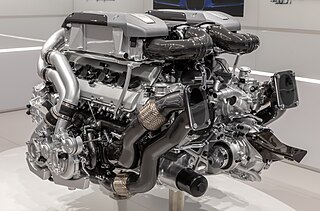
A petrol engine or gasoline engine is an internal combustion engine with spark-ignition, designed to run on petrol (gasoline) and similar volatile fuels.

Maxwell was an American automobile manufacturer which ran from about 1904 to 1925. The present-day successor to the Maxwell company was Chrysler, which acquired the company in 1925.

In automotive engineering, a grille covers an opening in the body of a vehicle to allow air to enter or exit. Most vehicles feature a grille at the front of the vehicle to protect the radiator and engine. Merriam-Webster describes grilles as "a grating forming a barrier or screen; especially: an ornamental one at the front end of an automobile." The word 'grille' is commonly misspelled as 'grill' which instead refers to the cooking method. Other common grille locations include below the front bumper, in front of the wheels, in the cowl for cabin ventilation, or on the rear deck lid. Grilles evolved from previously installed gravel shields that were designed to protect exposed radiators typically used on cars until the early 1930s.
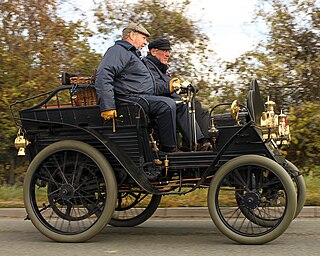
The Mors automobile factory was an early French car manufacturer. It was one of the first to take part in automobile racing, beginning in 1897, due to the belief of the company founder, Émile Mors, in racing's technical and promotional benefits. By the turn of the century, automobile racing had become largely a contest between Mors and Panhard et Levassor.
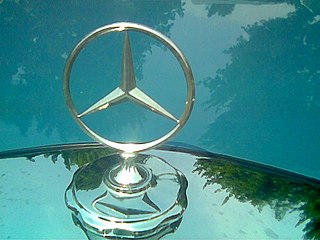
A hood ornament, also called radiator cap, motor mascot, or car mascot is a specially crafted model which symbolizes a car company like a badge, located on the front center portion of the hood. It has been used as an adornment nearly since the inception of automobiles.

Roosevelt was a brand of American automobile that was manufactured by the Marmon Motor Car Company of Indianapolis, Indiana, United States, during the 1929 and 1930 model years.

The Renault Reinastella is an automobile created by the French car maker Renault. The original Reinastella was a luxury-class car manufactured between 1929 and 1933.

The original Ford Model A is the first car produced by the Ford Motor Company, beginning production in 1903. Ernest Pfennig, a Chicago dentist, became the first owner of a Model A on July 23, 1903; 1,750 cars were made from 1903 through 1904 during Ford's occupancy of its first facility: the Ford Mack Avenue Plant, a modest rented wood-frame building on Detroit's East Side. The Model A was replaced by the Ford Model C during 1904 with some sales overlap.
The Haase was an American Veteran make of car produced by Northwestern Furniture Company in Milwaukee between 1902 and 1904. It was named after the company director at the time.
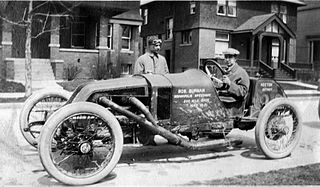
Keeton Motor Company was a brass era automobile maker based in Detroit, Michigan from 1912 to 1914.
The Harvard was a Brass Era car built in Troy and Hudson Falls, New York and later in Hyattsville, Maryland over the course of the period 1915 to 1921.

Calsonic Kansei Corporation was a Japanese automotive company with 58 manufacturing centres spread throughout the United States, European Union, South Korea, Mexico, Thailand, South Africa, India, China, and Malaysia.
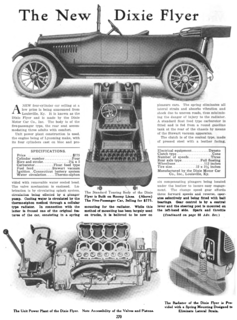
The Dixie Flyer was an automobile built in Louisville, Kentucky from 1916 until 1923. Dixie Flyers were marketed under the slogan of "The Logical Car." They may be classified as Brass Era cars or vintage cars.

Radiators are heat exchangers used for cooling internal combustion engines, mainly in automobiles but also in piston-engined aircraft, railway locomotives, motorcycles, stationary generating plant or any similar use of such an engine.

A horn is a sound-making device that can be equipped to motor vehicles, buses, bicycles, trains, trams, and other types of vehicles. The sound made usually resembles a "honk" or a "beep". The driver uses the horn to warn others of the vehicle's approach or presence, or to call attention to some hazard. Motor vehicles, ships and trains are required by law in some countries to have horns. Like trams, trolley cars and streetcars, bicycles are also legally required to have an audible warning device in many areas, but not universally, and not always a horn.
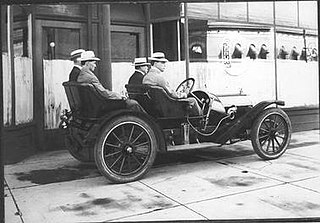
The Colburn Automobile Company was a Brass Era car manufacturer in Denver, Colorado. The company produced cars from 1906-1911. in their factory at 15th Street and Colfax Avenue.
This Continental car was built by the University Automobile Company located in New Haven. It was renamed the Continental Automobile Manufacturing Company in 1908. Chief engineer was C. S. Johnson. There is no known connection with other Continental automobiles.

Weigel Motors Ltd was a British automobile manufacturer from 1907–1910 at Coswell Road in London. The company built the first British cars to participate in Grand Prix Racing when it entered 2 cars in the 1907 French Grand Prix at Dieppe, driven by Gregor Laxen and Pryce Harrison. These were powered by Straight Eight engines displacing 14,866cc, formed by coupling two 40 hp engines in tandem. Financial difficulties emerged in 1907, as the company was reformed, and moved to a new factory in Olaf Street, Latimer Road, Notting Hill. For the 1908 French Grand Prix Weigel entered three four-cylinder cars, with engines displacing 12,781cc driven by Harrison, Laxen and Shannon. Again, none of the cars finished. The firm's assets were acquired in 1910 by Crowdy Limited, who continued manufacture of cars in the Olaf Street works, at first merely continuing the existing 25 hp and 40 hp Weigel designs and later producing a 19 hp four and a 29 hp six with dashboard radiators similar to those on Renault cars of the era. At the end of 1911 they moved to West Heath Works, Northfield, Birmingham producing cars with normally-located radiators, before going out of business.
The William E. Swigart Jr. Antique Automobile Museum, located in Huntingdon, Pennsylvania, is a 501(c)(3) non-profit museum dedicated to the preservation of American automobile history. The collections began as a private passion of founder W. Emmert Swigart in about 1920. The current museum opened in 1957.
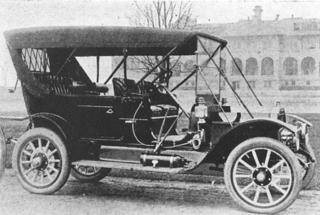
The Welch Motor Company was an American automobile company headquartered in Chelsea, Michigan. It started in 1901 and continued production of luxury vehicles until 1911 when it merged with General Motors.
References
- ↑ Kimes, Beverly Rae; Clark Jr., Henry Austin (1996). Standard Catalog of American Cars 1805-1942 (3rd ed.). Krause Publications. ISBN 978-0-87341-428-9.
David Burgess Wise, The New Illustrated Encyclopedia of Automobiles